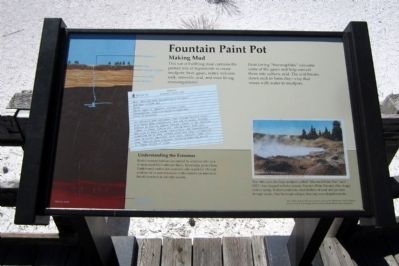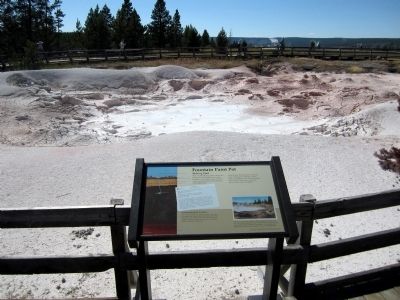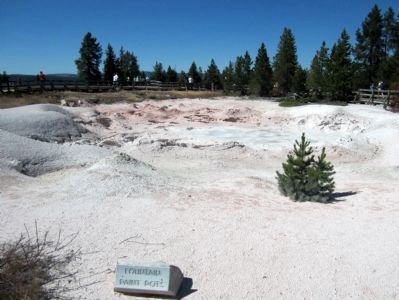Yellowstone National Park in Teton County, Wyoming — The American West (Mountains)
Fountain Paint Pot
Making Mud
This vat of bubbling mud contains the perfect mix of ingredients to create mudpots: heat, gases, rock, minerals, acid, and even living microorganisms!
Heat-loving “thermophiles” consume some of the gases and help convert them into sulfuric acid. The acid breaks down rock to form clay—clay that mixes with water in mudpots.
Understanding the Extremes
Earth’s extreme habitats are studied by scientists who seek to understand life’s ultimate limits. Knowledge gained from Earth-bound studies aids scientists who search for life (and evidence of its past existence) in the extreme environments found elsewhere in our solar system.
Year after year, this huge mudpot—called “Mammoth Paint Pots” until 1927—has changed with the seasons. Fountain Paint Pot spits thin, sloppy mud in spring. In drier conditions, thick bubbles of mud and gas ooze through cracks, then burst and collapse, forming cone-shaped mounds.
(sidebar)
Recipe for Mudpot
Fountain Paint Pot
Heat (derived from Yellowstone’s volcano)
Hydrogen sulfide gas
Water
Thick layer of rhyolite (volcanic rock)
Thermophiles (heat-loving microorganisms)
Pinch of minerals
Let volcanic heat and gases rise through Earth’s crust. Boil water deep underground, and add to gases. Process mixture by forcing upward through cracks in the rhyolite. Simmer in a large cooking pot, adding water from rain and snow to make muddy consistency. Add thermophiles, simmering while they consume gases and help turn mixture into an acidic marinade. Cook until rhyolite turns into clay. Garnish with minerals, allowing bubbling action to create swirls of color.
This exhibit made possible by a generous grant to the Yellowstone Park Foundation from the NASA Astrobiology Institute and Lockheed Martin Space Operations
Erected by Yellowstone Park Foundation.
Topics. This historical marker is listed in this topic list: Natural Features.
Location. 44° 33.035′ N, 110° 48.36′ W. Marker is in Yellowstone National Park, Wyoming, in Teton County. Marker can be reached from Grand Loop Road (U.S. 89) north of Firehole Lake Drive, on the right when traveling south. Located in the Lower Geyser Basin. Touch for map. Marker is in this post office area: Moran WY 83013, United States of America. Touch for directions.
Other nearby markers. At least 8 other markers are within 2 miles of this marker, measured as the crow flies. A different marker also named Fountain Paint Pot (within shouting distance of this marker); Earthquake’s Offspring (within shouting distance of this marker); White Dome Geyser (approx. 0.8 miles away); Captive Tourists (approx. 1.8 miles away); Nez Perce War (approx. 1.8 miles away); Chance Encounter (approx. 1.8 miles away); a different marker also named Chance Encounter (approx. 1.8 miles away); Murky Past . . . Promising Future (approx. 1.8 miles away). Touch for a list and map of all markers in Yellowstone National Park.
Also see . . . Yellowstone National Park. National Park Service (Submitted on August 1, 2011.)
Credits. This page was last revised on November 14, 2021. It was originally submitted on August 1, 2011, by Bernard Fisher of Richmond, Virginia. This page has been viewed 587 times since then and 9 times this year. Photos: 1, 2, 3. submitted on August 1, 2011, by Bernard Fisher of Richmond, Virginia.


